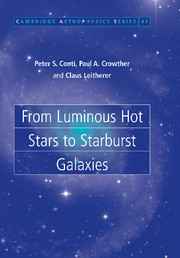Book contents
- Frontmatter
- Contents
- Preface
- Acknowledgements
- 1 Introduction
- 2 Observed properties
- 3 Stellar atmospheres
- 4 Stellar winds
- 5 Evolution of single stars
- 6 Binaries
- 7 Birth of massive stars and star clusters
- 8 The interstellar environment
- 9 From giant HII regions to HII galaxies
- 10 Starburst phenomena
- 11 Cosmological implications
- References
- Acronyms
- Symbols
- Object index
- Subject index
4 - Stellar winds
Published online by Cambridge University Press: 28 October 2009
- Frontmatter
- Contents
- Preface
- Acknowledgements
- 1 Introduction
- 2 Observed properties
- 3 Stellar atmospheres
- 4 Stellar winds
- 5 Evolution of single stars
- 6 Binaries
- 7 Birth of massive stars and star clusters
- 8 The interstellar environment
- 9 From giant HII regions to HII galaxies
- 10 Starburst phenomena
- 11 Cosmological implications
- References
- Acronyms
- Symbols
- Object index
- Subject index
Summary
Stellar winds are ubiquitous amongst massive stars, although the physical processes involved depend upon the location of the star within the H-R diagram. Mass-loss crucially affects the evolution and fate of a massive star (Chapter 5), while the momentum and energy expelled contribute to the dynamics and energetics of the ISM (Chapter 8). The interested reader is referred to the monograph by Lamers & Cassinelli (1999) on the topic of stellar winds, or Kudritzki & Puls (2000) for a more detailed discussion of mass-loss from OB and related stars.
The existence of winds in massive stars was first proposed by Beals (1929) to explain the emission line spectra of Wolf–Rayet stars. This gained observational support in the 1960s when the first rocket UV missions revealed the characteristic P Cygni signatures of massloss from CIV λ1550, SilV λ1400, and NV λ1240 in O stars (Morton 1967). A theoretical framework for mass-loss in hot stars was initially developed by Lucy & Solomon (1970) involving radiation pressure from lines, and refined by Castor, Abbott, & Klein (1975), thereafter known as CAK theory. The observational characteristics of stellar winds are velocity and density. The former can be directly observed, whilst the latter relies on a varying complexity of theoretical interpretation.
Radiation pressure
When a photon is absorbed or scattered by matter, it imparts its energy, hv, and momentum, hv/c, where h is Planck's constant and c is the velocity of light. Consequently, radiation is a very inefficient carrier of momentum.
- Type
- Chapter
- Information
- From Luminous Hot Stars to Starburst Galaxies , pp. 67 - 98Publisher: Cambridge University PressPrint publication year: 2008

